ECO mode Citroen DS5 RHD 2016 1.G Owner's Guide
[x] Cancel search | Manufacturer: CITROEN, Model Year: 2016, Model line: DS5 RHD, Model: Citroen DS5 RHD 2016 1.GPages: 512, PDF Size: 60.28 MB
Page 136 of 512
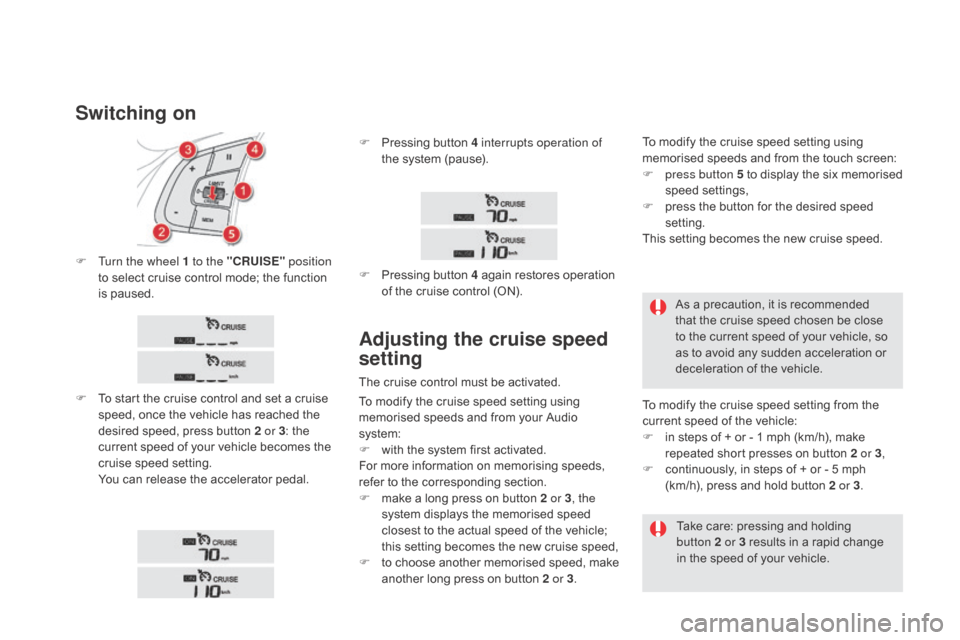
F Turn the wheel 1 to the "cRUISE" position
to select cruise control mode; the function
is paused.
F
T
o start the cruise control and set a cruise
speed, once the vehicle has reached the
desired speed, press button 2 or 3 : the
current speed of your vehicle becomes the
cruise speed setting.
Y
ou can release the accelerator pedal.
Switching on
F Pressing button 4 interrupts operation of the system (pause).
F
P
ressing button 4 again restores operation
of the cruise control (ON).
Adjusting the cruise speed
setting
The cruise control must be activated. As a precaution, it is recommended
that the cruise speed chosen be close
to the current speed of your vehicle, so
as to avoid any sudden acceleration or
deceleration of the vehicle.
To modify the cruise speed setting from the
current speed of the vehicle:
F
i
n steps of + or - 1 mph (km/h), make
repeated short presses on button 2 or 3 ,
F
c
ontinuously, in steps of + or - 5 mph
(km/h), press and hold button 2 or 3 .
Take care: pressing and holding
button
2 or 3 results in a rapid change
in the speed of your vehicle.
To modify the cruise speed setting using
memorised speeds and from your Audio
system:
F
w
ith the system first activated.
For more information on memorising speeds,
refer to the corresponding section.
F
m
ake a long press on button 2 or 3 , the
system displays the memorised speed
closest to the actual speed of the vehicle;
this setting becomes the new cruise speed,
F
t
o choose another memorised speed, make
another long press on button 2 or 3. To modify the cruise speed setting using
memorised speeds and from the touch screen:
F
p
ress button 5 to display the six memorised
speed settings,
F
p
ress the button for the desired speed
setting.
This setting becomes the new cruise speed.
Page 146 of 512

Foglamp selection ring
The foglamps operate with dipped and main beam headlamps.
Rotate and release the ring:
F
f
or wards a first time to switch on the front
foglamps,
F
f
or wards a second time to switch on the
rear foglamps,
F
r
ear wards a first time to switch off the rear
foglamps,
F
r
ear wards a second time to switch of the
front fog lamps. When the headlamps switch off with automatic
illumination of headlamps (AUTO model)
or when the dipped beam headlamps are
switched off manually, the foglamps and
sidelamps remain on.
F
T
urn the ring rear wards to switch off
the foglamps, the sidelamps will then
switch off. In good or rainy weather, by both day
and night, the front foglamps and the
rear foglamps are prohibited. In these
situations, the power of their beams
may dazzle other drivers. They should
only be used in fog or falling snow.
In these weather conditions, you should
switch on the foglamps and dipped
beam headlamps manually, as the
sunshine sensor may detect sufficient
light.
Do not forget to switch off the front and
rear foglamps when they are no longer
necessary.
Front and rear
foglamps
Page 147 of 512
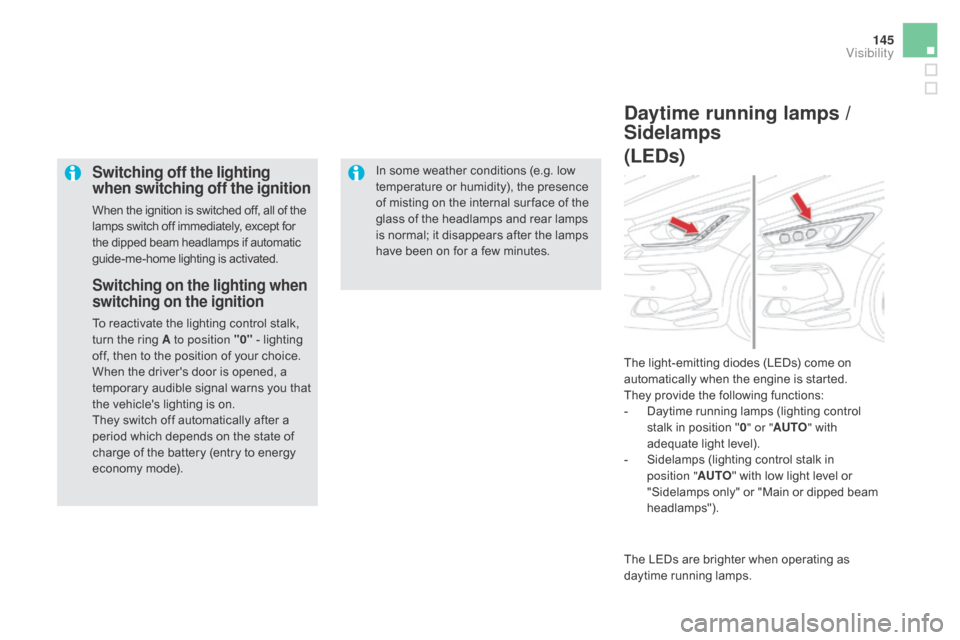
145
Switching off the lighting
when switching off the ignition
When the ignition is switched off, all of the
lamps switch off immediately, except for
the dipped beam headlamps if automatic
guide-me-home lighting is activated.In some weather conditions (e.g. low
temperature or humidity), the presence
of misting on the internal sur face of the
glass of the headlamps and rear lamps
is normal; it disappears after the lamps
have been on for a few minutes.
Switching on the lighting when
switching on the ignition
To reactivate the lighting control stalk,
turn the ring A to position "0"
- lighting
off, then to the position of your choice.
When the driver's door is opened, a
temporary audible signal warns you that
the vehicle's lighting is on.
They switch off automatically after a
period which depends on the state of
charge of the battery (entry to energy
economy mode).
daytime running lamps /
Sidelamps
(LE
ds)
The light-emitting diodes (LEDs) come on
automatically when the engine is started.
They provide the following functions:
-
D
aytime running lamps (lighting control
stalk in position " 0" or " AUTO " with
adequate light level).
-
S
idelamps (lighting control stalk in
position " AUTO" with low light level or
"Sidelamps only" or "Main or dipped beam
headlamps").
The LEDs are brighter when operating as
daytime running lamps.
Visibility
Page 159 of 512

157
1. Front - rear cour tesy lamp
2. Front map reading lamp s
3.
R
ear map reading lamps
4.
I
nterior mood LE
ds
Courtesy lamps
In this position, the courtesy lamp
comes on gradually:
Front - rear courtesy lamps
Take care to avoid leaving anything in
contact with the courtesy lamps.
With the "permanent lighting" mode, the lighting
time varies according to the circumstances:
- with the ignition off, approximately
ten m inutes,
- in energy economy mode, approximately thirty seconds,
- with the engine running, unlimited.
- when the vehicle is unlocked,
- w hen the electronic key is removed from
the reader,
-
w
hen opening a door,
-
w
hen the remote control locking button is
activated, in order to locate your vehicle.
It switches off gradually:
-
w
hen the vehicle is locked,
-
w
hen the ignition is switched on,
-
3
0 seconds after the last door is closed.Permanently off.
Permanent lighting.
Front - rear map reading
lamps
F With the ignition on, press the corresponding switch.
Visibility
Page 229 of 512
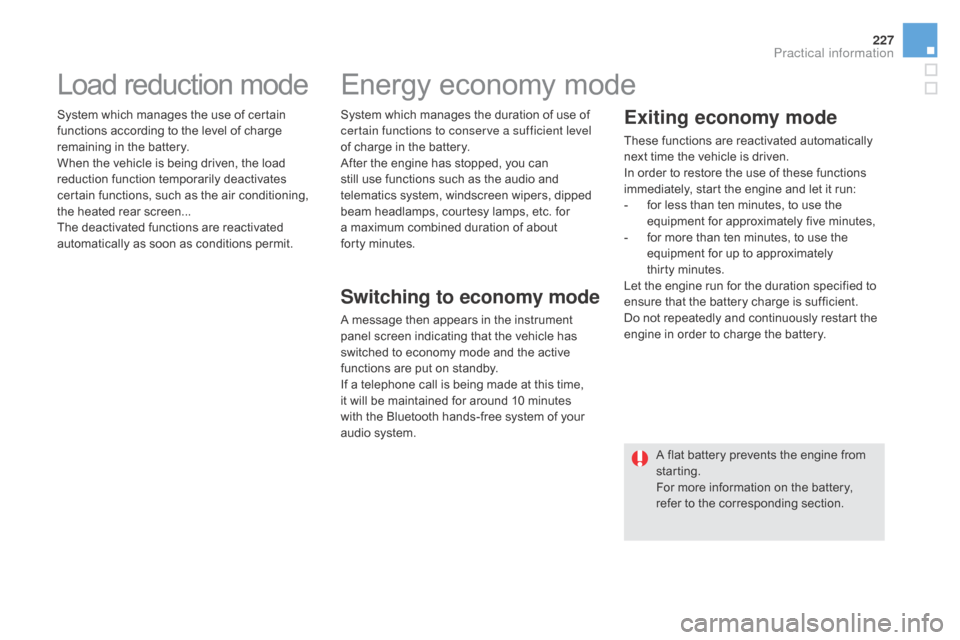
227
Load reduction mode
System which manages the use of certain
functions according to the level of charge
remaining in the battery.
When the vehicle is being driven, the load
reduction function temporarily deactivates
certain functions, such as the air conditioning,
the heated rear screen...
The deactivated functions are reactivated
automatically as soon as conditions permit.System which manages the duration of use of
certain functions to conserve a sufficient level
of charge in the battery.
After the engine has stopped, you can
still use functions such as the audio and
telematics system,
windscreen wipers, dipped
beam headlamps,
courtesy lamps, etc. for
a maximum combined duration of about
forty
m
inutes.
Energy economy mode
Switching to economy mode
A message then appears in the instrument
panel screen indicating that the vehicle has
switched to economy mode and the active
functions are put on standby.
If a telephone call is being made at this time,
it will be maintained for around 10 minutes
with the Bluetooth hands-free system of your
audio
system.
Exiting economy mode
These functions are reactivated automatically
next time the vehicle is driven.
In order to restore the use of these functions
immediately, start the engine and let it run:
-
f
or less than ten minutes, to use the
equipment for approximately five minutes,
-
f
or more than ten minutes, to use the
equipment for up to approximately
thirty
m
inutes.
Let the engine run for the duration specified to
ensure that the battery charge is sufficient.
Do not repeatedly and continuously restart the
engine in order to charge the battery.
A flat battery prevents the engine from
starting.
For more information on the battery,
refer to the corresponding section.
Practical information
Page 245 of 512
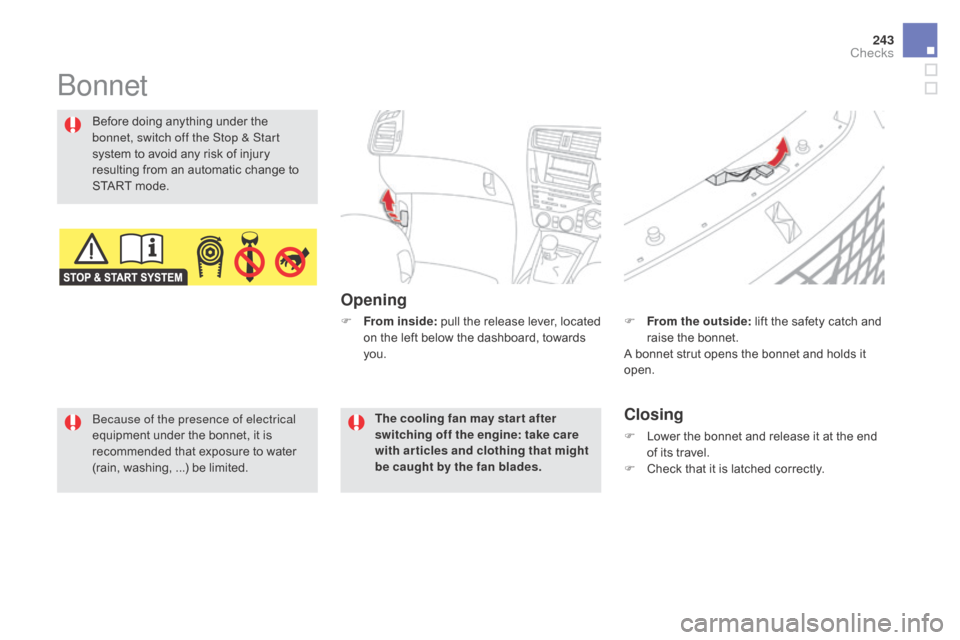
243
Bonnet
Opening
Before doing anything under the
bonnet, switch off the Stop & Start
system to avoid any risk of injury
resulting from an automatic change to
START mode.
closing
F Lower the bonnet and release it at the end of its travel.
F
C
heck that it is latched correctly.
F
F
rom the outside: lift the safety catch and
raise the bonnet.
A bonnet strut opens the bonnet and holds it
open.
Because of the presence of electrical
equipment under the bonnet, it is
recommended that exposure to water
(rain, washing, ...) be limited. The cooling fan may star t after
switching off the engine: take care
with articles and clothing that might
be caught by the fan blades.
F
Fr
om inside:
pull the release lever, located
on the left below the dashboard, towards
you.
checks
Page 267 of 512
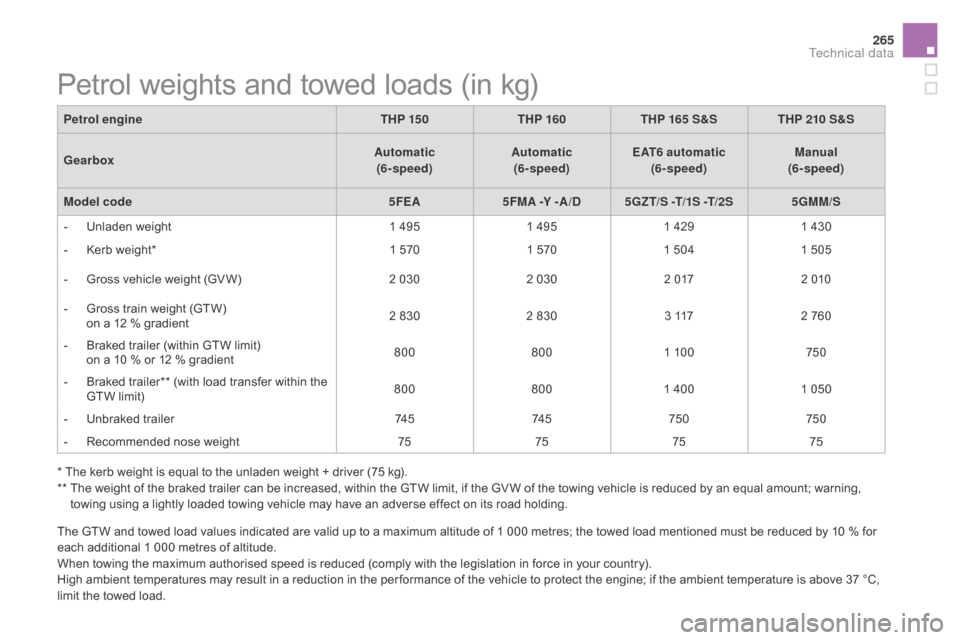
265
Petrol weights and towed loads (in kg)
Petrol engineTHP 15 0THP 160 THP 165 S&S THP 210 S&S
ge
arbox Automatic
(6- speed) Automatic
(6- speed) EAT6 automatic
(6- speed) Manual
(6- speed)
Model code 5FEA5FMA -Y -A /
d5gZ
T/S -T/1S -T/2S5
gMM/
S
-
U
nladen weight 1 4951 495 1 4291 430
-
K
erb weight* 1 5701 5701 504 1 505
-
G
ross vehicle weight (GV W) 2 0302 030 2 0172 010
-
G
ross train weight (GTW)
o
n a 12 % gradient 2 830
2 830 3 1172 760
-
B
raked trailer (within GTW limit)
o
n a 10 % or 12 % gradient 800
8001 100 750
-
B
raked trailer** (with load transfer within the
GTW limit) 800
8001 400 1 050
-
U
nbraked trailer 74 574 5750 750
-
R
ecommended nose weight 75757575
* The kerb weight is equal to the unladen weight + driver (75 kg).
**
T
he weight of the braked trailer can be increased, within the GTW limit, if the GV W of the towing vehicle is reduced by an equal amount; warning,
towing using a lightly loaded towing vehicle may have an adverse effect on its road holding.
The GTW and towed load values indicated are valid up to a maximum altitude of 1 000 metres; the towed load mentioned must be reduced by 10 % for
each additional 1 000 metres of altitude.
When towing the maximum authorised speed is reduced (comply with the legislation in force in your country).
High ambient temperatures may result in a reduction in the per formance of the vehicle to protect the engine; if the ambient temperature is above 37 °C,
limit the towed load.
Technical data
Page 268 of 512

* The kerb weight is equal to the unladen weight + driver (75 kg).Petrol engine
THP 165 S&STHP 210 S&S
ge
arbox
EAT6 automatic
(6- speed) Manual
(6- speed)
Model code 5
gZ
T/S -T/1S -T/2S
5
gMM/
S
-
U
nladen weight
1 5391 539
-
K
erb weight*
1 6141 614
-
G
ross vehicle weight (GV W)
2 2252 160
-
G
ross train weight (GTW)
o
n a 12% gradient
3 225
2 910
-
B
raked trailer (within the GTW limit)
o
n a 10% or 12% gradient
1 000
750
-
U
nbraked trailer
750750
-
R
ecommended nose weight
7575
The GTW and towed load values indicated are valid up to a maximum altitude of 1 000 metres; the towed load mentioned must be reduced by 10 % for
each additional 1 000 metres of altitude.
When towing the maximum authorised speed is reduced (comply with the legislation in force in your country).
High ambient temperatures may result in a reduction in the per formance of the vehicle to protect the engine; if the ambient temperature is above 37 °C,
limit the towed load.
Petrol weights and towed loads (in kg) - Commercial versions
Page 271 of 512
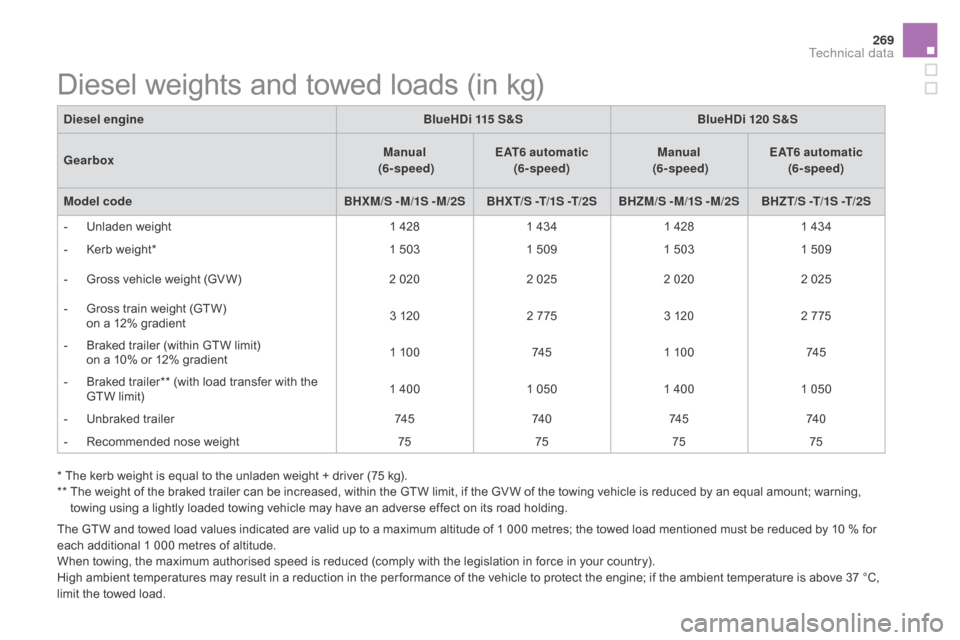
269
The GTW and towed load values indicated are valid up to a maximum altitude of 1 000 metres; the towed load mentioned must be reduced by 10 % for
each additional 1 000 metres of altitude.
When towing, the maximum authorised speed is reduced (comply with the legislation in force in your country).
High ambient temperatures may result in a reduction in the per formance of the vehicle to protect the engine; if the ambient temperature is above 37 °C,
limit the towed load. * The kerb weight is equal to the unladen weight + driver (75 kg).
**
T
he weight of the braked trailer can be increased, within the GTW limit, if the GV W of the towing vehicle is reduced by an equal amount; warning,
towing using a lightly loaded towing vehicle may have an adverse effect on its road holding.
di
esel engine
BlueH d i 115 S&S
BlueH d i 120
S&S
ge
arbox
Manual
(6- speed) EAT6 automatic
(6- speed) Manual
(6- speed) EAT6 automatic
(6- speed)
Model code BHXM/S -M/1S -M/2SBHX T/S -T/1S -T/2SBHZM/S -M/1S -M/2S BHZT/S -T/1S -T/2S
-
U
nladen weight
1 4281 434 1 4281 434
-
K
erb weight*
1 5031 509 1 5031 509
-
G
ross vehicle weight (GV W)
2 0202 0252 020 2 025
-
G
ross train weight (GTW)
o
n a 12% gradient
3 120
2 775 3 1202 775
-
B
raked trailer (within GTW limit)
o
n a 10% or 12% gradient
1 100
74 51 100 74 5
-
B
raked trailer** (with load transfer with the
GTW limit) 1 400
1 0501 400 1 050
-
U
nbraked trailer
74 574 074 5 74 0
-
R
ecommended nose weight
75757575
Diesel weights and towed loads (in kg)
Technical data
Page 272 of 512

* The kerb weight is equal to the unladen weight + driver (75 kg).
** T he weight of the braked trailer can be increased, within the GTW limit, if the GV W of the towing vehicle is reduced by an equal amount; warning,
towing using a lightly loaded towing vehicle may have an adverse effect on its road holding.
The GTW and towed load values indicated are valid up to a maximum altitude of 1 000 metres; the towed load mentioned must be reduced by 10 % for
each additional 1 000 metres of altitude.
When towing, the maximum authorised speed is reduced (comply with the legislation in force in your country).
High ambient temperatures may result in a reduction in the per formance of the vehicle to protect the engine; if the ambient temperature is above 37 °C,
limit the towed load.
di
esel engine
BlueH d i 135
S&S BlueH d i
15 0 S&S BlueH d i 180 S&S
ge
arbox
Manual
(6- speed) Manual
(6- speed) EAT6 automatic
(6- speed)
Model code AHV AHSM/S - M/1S - M/2SAHX AHRM/S -M/1S -M/2S AHW T/S -T/1S -T/2S
-
U
nladen weight
1 5371 5371 540
-
K
erb weight*
1 6121 6121 615
-
G
ross vehicle weight (GV W)
2 1302 130 2 125
-
G
ross train weight (GTW)
o
n a 12% gradient
3 330
3 330 3 325
-
B
raked trailer (within GTW limit)
o
n a 10% or 12% gradient
1 200
1 2001 200
-
B
raked trailer** (with load transfer with the
GTW limit) 1 500
1 5001 500
-
U
nbraked trailer
750750750
-
R
ecommended nose weight
757575
Diesel weights and towed loads (in kg)